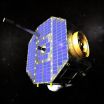(Press-News.org) When NASA launched the Interstellar Boundary Explorer (IBEX) on October 19, 2008, space physicists held their collective breath for never-before-seen views of a collision zone far beyond the planets, roughly 10 billion miles away. That's where the solar wind, an outward rush of charged particles and magnetic fields continuously spewed by the Sun, runs into the flow of particles and fields that permeates interstellar space in our neighborhood of the Milky Way galaxy.
No spacecraft had ever imaged the collision zone, which occurs in a region known as the heliosheath, because it emits no light. But the two detectors on IBEX are designed to "see" what the human eye cannot. The interaction of the solar wind and interstellar medium creates energetic neutral atoms of hydrogen, called ENAs, that zip away from the heliosheath in all directions. Some of these atoms pass near Earth, where IBEX records their arrival direction and energy. As the spacecraft slowly spins, the detectors gradually build up pictures of the ENAs as they arrive from all over the sky.
Mission scientists got their first surprise six months after launch, once the spacecraft had scanned enough overlapping strips of sky to create a complete 360° map. Instead of recording a relatively even distribution all the way around, as expected, IBEX found that the counts of ENAs — and thus the strength of the interaction in the heliosheath — varied dramatically from place to place. The detectors even discovered a long, enhanced "ribbon," accentuated by an especially intense hotspot or "knot," arcing across the sky. (IBEX Explores Galactic Frontier, Releases First-Ever All-Sky Map)
Now scientists have finished assembling a second complete sweep around the sky, and IBEX has again delivered an unexpected result: the map has changed significantly. Overall, the intensity of ENAs has dropped 10% to 15%, and the hotspot has diminished and spread out along the ribbon. Details of these findings appear in the September 27th issue of Journal of Geophysical Research (Space Physics).
"We thought we might detect small changes occurring gradually throughout the Sun's 11-year-long activity cycle, but not over just 6 months," notes David McComas (Southwest Research Institute), principal investigator for the IBEX mission and the paper's lead author. "These observations show that the interaction of the Sun with the interstellar medium is far more dynamic and variable than anyone envisioned."
In the past, space physicists had little notion of what to expect along the boundary where the Sun's own magnetic bubble, the heliosphere, meets interstellar space. Even though the solar wind travels outward at roughly a million miles per hour, it still takes about a year to reach the heliosphere's edge. Also, the encounter zone within the heliosheath is believed to be several billion miles thick (roughly Pluto's distance from the Sun). Finally, the ENAs take another six months to many years to complete the return trip back to Earth, depending on their direction and energy.
With ENAs starting out from such a wide range of distances and traveling back toward Earth at different speeds, IBEX mission scientists had expected that any highs and lows in intensity arising within the heliosheath would be hopelessly smeared out in the spacecraft's all-sky maps. So they're elated by the variations and changes seen so far by IBEX. These early results hint that the solar wind and the interstellar flow might be interacting in a thinner layer than many researchers had imagined possible.
McComas says the dropoff in intensity between the two all-sky maps perhaps makes sense, because the Sun is only now emerging from an unusually long period of very low activity and a correspondingly weak solar wind. The fewer the solar-wind particles that reached the heliosheath in recent years, the fewer the ENAs that got created. "We didn't plan it this way," says McComas, "but it's an almost perfect situation, in that we're seeing the interaction in its simplest state — before trying to interpret what turns out to be a much more complicated interaction than anticipated."
If IBEX remains healthy, and if the team gets approval to continue well past its planned two-year mission, then the changes it's seeing in the distant heliosheath should become more dramatic as solar activity ramps up later in this decade.
"The surprising results from IBEX show that there is still exciting science that can be done with small missions," comments Eric Christian, a member of the spacecraft's research team and the program's Deputy Mission Scientist at the Goddard Space Flight Center. "This is clearly a huge success for the Explorer program." IBEX is one of a dozen Explorer-class missions operated by NASA's Science Mission Directorate.
"The public might think that scientists make measurements and instantly know what's going on, but that is not how science really works," McComas observes. "We thought the outer heliosphere would be stable over time — and IBEX is showing us that it's not. This is changing the game completely."
INFORMATION:
IBEX finds surprising changes at solar boundary
2010-10-01
ELSE PRESS RELEASES FROM THIS DATE:
NIH scientists describe how salmonella bacteria spread in humans
2010-10-01
VIDEO:
See a time-lapse series showing hyper-replication of Salmonella bacteria (red) in epithelial cells from two to seven hours after infection.
Click here for more information.
New findings by National Institutes of Health scientists could explain how Salmonella bacteria, a common cause of food poisoning, efficiently spread in people. In a study published this week in the Proceedings of the National Academy of Sciences, researchers describe finding a reservoir of rapidly ...
Slicing proteins with Occam's Razor
2010-10-01
A cheetah lies still in the grass. Finally, a gazelle comes into view. The cheetah plunges forward, reaches sixty-five miles per hour in three seconds, and has the hapless gazelle by the jugular in less than a minute. Then it must catch its breath, resting before eating.
A blue whale surfaces, blasting water high from its blowhole. It breathes in great gasps, filling its thousand-gallon lungs with air. Then it descends again to look for krill, staying below for 10, 20, even 30 minutes before taking another breath.
Both animals need oxygen, of course. And both depend ...
Iowa State University researcher examines mosquito gene for new disease response
2010-10-01
Ames, Iowa - An Iowa State University researcher searched for new genes that are turned on during infection in a type of mosquito that is not only a pest, but transmits disease-causing pathogens.
Lyric Bartholomay, assistant professor of entomology, along with colleagues from around the world, infected the common southern house mosquito (Culex quinquefasciatus) with various pathogens to see which mosquito genes are activated in response to the infection.
Bartholomay is the first author on the paper, "Pathogenomics of Culex quinquefasciatus and Meta-Analysis of Infection ...
Short and long sleep in early pregnancy linked to high blood pressure in the third trimester
2010-10-01
DARIEN, IL – A study in the Oct. 1 issue of the journal Sleep found that getting too little or too much sleep in early pregnancy is associated with elevated blood pressure in the third trimester. The study suggests that improving prenatal sleep hygiene may provide important health benefits.
Results show that the mean systolic blood pressure in the third trimester was 114 mm Hg in women with a normal self-reported nightly sleep duration of nine hours in early pregnancy, 118.05 mm Hg in women who reported sleeping six hours or less per night, and 118.90 mm Hg in women ...
Is photoscreening the best way to catch 'lazy eye'?
2010-10-01
SAN FRANCISCO, CA– Amblyopia, known as "lazy eye," is a major cause of vision problems in children and a common cause of blindness in people aged 20 to 70 in developed countries. In amblyopia the person's stronger eye is favored and his/her weaker eye gradually loses visual power as a result. When the condition is detected and treated before age 7, more than 75 percent of children achieve 20/30 vision or better, the Amblyopia Treatment Study reports. But parents and teachers can easily miss this problem–especially in very young children. Pediatric ophthalmologists (Eye ...
Most suicidal adolescents receive follow-up care after ER visits
2010-10-01
SAN FRANCISCO – For suicidal adolescents, the emergency department (ED) is most often the chosen portal to mental health services. New research, presented Friday, Oct. 1, at the American Academy of Pediatrics (AAP) National Conference and Exhibition in San Francisco, looks at what happens to the 30 percent of suicidal adolescents who are discharged from the ED and whether they go on to access additional mental health services.
In "Predictors of Mental Health Follow up Among Adolescents with Suicidal Ideation After Emergency Department Discharge," researchers followed ...
New lung cancer research finds half of advanced lung cancer patients receive chemotherapy
2010-10-01
For the first time to date, research published in the October edition of the Journal of Thoracic Oncology (JTO) sought to determine the use of chemotherapy in a contemporary, diverse non-small cell lung cancer (NSCLC) population encompassing all patient ages. Prior population-based studies have shown that only 20 to 30 percent of advanced lung cancer patients receive chemotherapy treatment. These studies have previously relied on the Medicare-linked Surveillance, Epidemiology, and End Results (SEER) database, thus excluding the 30 to 35 percent of lung cancer patients younger ...
TRUST study data confirms safety and efficacy of erlotinib for advanced lung cancer
2010-10-01
Featured in the October edition of the Journal of Thoracic Oncology (JTO), data from The Tarceva Lung Cancer Survival Treatment (TRUST) confirms the safety and efficacy profile of erlotinib, a highly potent oral active, reversible inhibitor of epidermal growth factor receptor (EGFR) tyrosine-kinase (TK) activity in a large heterogeneous non-small cell lung cancer (NSCLC) population.
Erlotinib has been shown to significantly increase survival for patients with previously treated advanced NSCLC. Certain groups of patients with NSCLC, such as those with a particular type ...
Genetically altered trees, plants could help counter global warming
2010-10-01
Forests of genetically altered trees and other plants could sequester several billion tons of carbon from the atmosphere each year and so help ameliorate global warming, according to estimates published in the October issue of BioScience.
The study, by researchers at Lawrence Berkeley National Laboratory and Oak Ridge National Laboratory, outlines a variety of strategies for augmenting the processes that plants use to sequester carbon dioxide from the air and convert it into long-lived forms of carbon, first in vegetation and ultimately in soil.
Besides increasing the ...
Adjunctive rufinamide reduces refractory partial-onset seizures
2010-10-01
Researchers from the Arkansas Epilepsy Program found treatment with rufinamide results in a significant reduction in seizure frequency compared with placebo, for patients with uncontrolled partial-onset seizures (POS). Details of this study are now available online in Epilepsia, a journal published by Wiley-Blackwell on behalf of the International League Against Epilepsy.
Epilepsy affects up to 2% of the worldwide population according to the Centers for Disease Control and Prevention. More than half of these patients experience POS, or focal seizures, which are initiated ...


